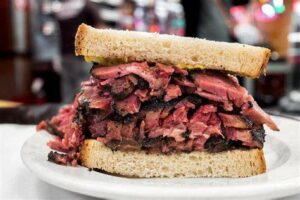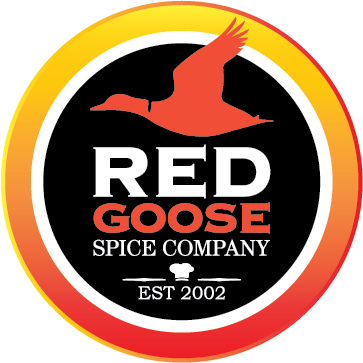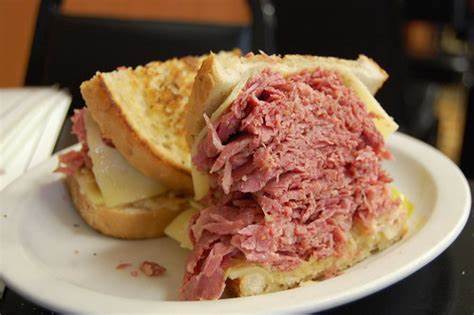With St. Patrick’s Day right around the corner, we’ll spare you all of the usual traditional Irish phrases and “corny” or should we say “corned-e” history lessons.
Save one.
Did you know that the word “corned” in reference to the popular curing of meats actually comes NOT from the residents of Cornwall, England, (the Cornish), but, (according to most historians), from the fact that the original meats used in this preservation process, were preserved using, among other ingredients, salt.
Not just any salt, but salt, potassium nitrate, the size of corn kernels.
This corn sized salt is supposedly responsible for the name “corned”.
Interestingly, it’s a phrase actually attributed to the English, not the Irish, even though the Irish were more well known for their salt cured and processed meat recipes.
Of course, today’s recipes still use salt, (most often kosher or sea salt to avoid the iodine taste), but it’s much finer.
We also, nowadays, use a different meat that was originally chosen by both the English and the Irish for “corning”, which was pork.
Usually from the belly.
In England, and throughout Britain, pork was cheap and plentiful for the commoners who prepared this dish.
Beef however, was a luxury.
All that changed when their migration to America began. Beef was more plentiful, and relatively cheap.
The switch was on.
One thing did stay the same. They stuck with the same primal cuts of beef, as they once used from the hog.
That is, the belly or brisket.
Corned beef was here to stay and became the preferred meat for this corned dish, now so closely associated with Ireland and St. Patrick’s Day.
What about Pastrami?

The difference between corned beef and pastrami.
There are a lot of similarities between corned beef and pastrami but there are some significant differences as well.
Here is a simple explanation:
The similarities are:
- They come from the same “general” vicinity of the animal (the brisket or belly/navel/deckle/plate area). Corned beef almost exclusively from the brisket cut and pastrami mostly from the plate or navel area).
- They are both cooked with moist heat (not roasted.)
- Both are cured.
- Both make iconic deli sandwiches!
The differences are:
- Corned beef is boiled or simmered while pastrami is generally steamed.
- Pastrami is smoked, corned beef is not
- The seasonings are slightly different, generally, pastrami is a bit more seasoned and uses black pepper prominently.
Whether you enjoy preparing Corned Beef OR Pastrami, one of the things that you can always know is that the Red Goose Spice company not only has all the herbs and spices you need to create both of these amazing and historic dishes, but we carry a Pickling Spice Blend that is just outstanding!
This is no wimpy, off the supermarket shelf, down the middle of the road pickling spice recipe, but instead, chocked full of crushed bay leaves, cinnamon, mustard seed, allspice berries, whole black pepper, coriander, whole chiles, dill seed and whole cloves.
And amazing blend for amazing results.


Pingback: 웹툰 사이트
Pingback: evoplay ค่ายเกมสล็อตแตกง่าย จ่ายหนัก
Pingback: egg freezing
Pingback: buy suboxone strips online
Pingback: ทีเด็ดบอลเต็ง 1 ตัว อย่างไรให้เข้าเล่นๆ ตามโปร โบนัสฟรีล่าสุด
Pingback: บุหรี่นอก
Pingback: https://webcache.googleusercontent.com/search?q=cache:LLhoqU_p31AJ:https://www.outlookindia.com/outlook-spotlight/the-14-best-press-release-distribution-services-of-for-enhanced-visibility-and-reach--news-301112&hl=en&gl=uk
Pingback: flower delivery bangkok
Pingback: aksara178
Pingback: sucker punch pro RTF
Pingback: lsm99live
Pingback: kojic acid soap
Pingback: faw99 สล็อต
Pingback: Trustbet
Pingback: พรมรถ
Pingback: this post
Pingback: รวมเว็บพนันออนไลน์
Pingback: sex trẻ em
Pingback: คายัค
Pingback: trang chủ go88
Pingback: แทงหวย24
Pingback: auto collision shops near me
Pingback: ชอบหีสวย.com
Pingback: เว็บปั้มไลค์
Pingback: 86kub
Pingback: fuckboy